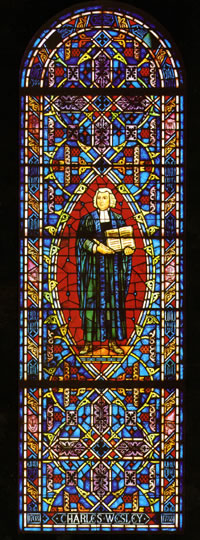
After returning to England, Wesley spent several years at Oxford preaching and lecturing as his health would permit. An experience of God’s love came to him on May 21, 1738, just three days prior to his brother’s Aldersgate experience. It inspired many of the hymns he wrote, estimated at 6,550. Much of the enthusiasm of the early days of Methodism came from the great hymns of Charles Wesley.
He moved to London where he continued the ministry he had known in the Holy Club, visiting prisoners and helping the destitute as his health permitted.
Although Wesley often preached in Methodist chapels built by his brother, he maintained a close relationship with the Church of England. It was his desire when he died on March 29. 1788, to be buried in the consecrated ground of St. Marlebone Church instead of City Road Chapel.
The left side border symbols of the Charles Wesley window, numbered from top to bottom, are: 1. a monasterboice cross with a circle joining the vertical and horizontal members of the cross representing eternity and signifying the eternal effect of redemption; 2. a “Sanctus-Sanctus-Sanctus” triangle, a symbol of the Holy Trinity in the form of a triangle, translating as “Holy-Holy-Holy;” and 3. the shield of St. Stephen featuring Stephen’s coat that was held by Saul of Tarsus, with stones symbolizing the manner of Stephen’s martyrdom.
The right side border symbols of the Charles Wesley window, numbered from top to bottom, are: 1. a lyre, an emblem of praise, representing the musical ability of Charles Wesley; 2. a laver or basin, a true example of the spirit of service, symbolizing the Savior’s washing of feet at the Last Supper; and 3. a menorah, an ancient lamp stand, signifying Christ as the “Light of the World.”














